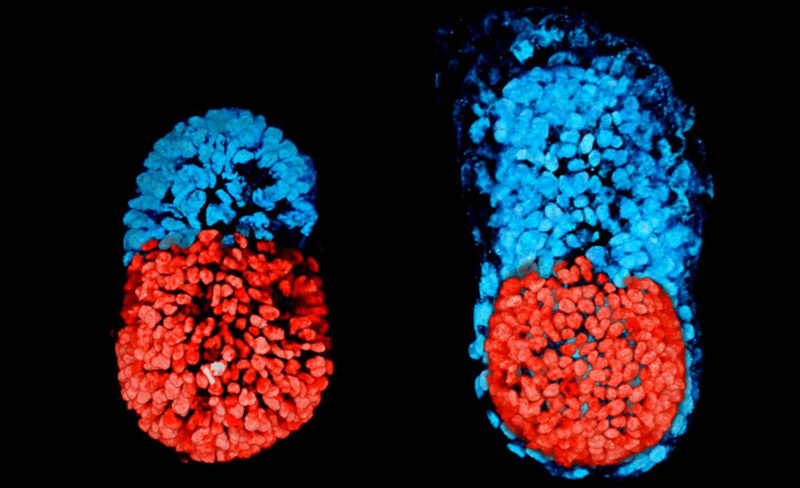Researchers from the University of Cambridge in UK have managed to nurture a functional embryo without sperm or eggs from scratch with the aid of two types of mice stem cells to fabricate life in a Petri dish within a year after a major breakthrough.
They are hoping that this procedure could resolve some most important mysteries about how life was created. This important discovery, on the other hand, could boost research into the causes of infertility and miscarriage.

The red part is embryonic, and the blue part is extra embryonic which means it would eventually form the placenta
It is actually the world’s first experiment in creating life from scratch. Researchers let the stem cells grow outside the body in a blob of gel and after that this cells transformed into several early stage internal organs – similar to that of the usual embryo.
Experts say that the same technique could be used to produce human embryo.
According to study leader, Professor Magdalena Zernicka-Goetz “We are very optimistic that this will allow us to study key events of this critical stage of human development without actually having to work on standard embryos.”
“It has anatomically correct regions that develop in the right place and at the right time. This was the most amazing thing for us.” She added
The failure of an embryo to embed itself into the uterus is a major cause of early pregnancy loss but the changes that take place in the human embryo at this stage remain unknown.
In cases where in the mammalian egg has been fertilized by a sperm, this will be divided in multiple times and could generate a small, free-floating ball of stem cells called blastocyst.
Although previous attempts to grow an embryo have fallen short, they found out that the life doesn’t simply grow from embryonic stem cells (ECSs) alone, there two other types of stem cells that are also essential for proper development – the extra embryonic trophoblast stem cells (TSCs) and primitive endoderm stem cells.
The embryonic stem cells develop into the different types of cell that make up the human body such as the heart, liver, and skin.
The ESCs harmonizing properly with the additional stem cells produced the placenta and yolk sac, which guarantee that the organs can develop appropriately and are given a stable supply of nutrients.
Babies created without sperm cell or egg cell could now be a reality through mouse embryos from stem cells
With the combination of the used of the genetically-modified mouse ESCs and TSCs and built a 3D, gel based scaffold, the research team were confident enough that it could grow around to mimic the form of a natural embryo.
The two stem cells were put together to allow them to speak to each other and surprisingly those cells could organize themselves without any help.
The embryos reached a development stage approximately the same to a third of the way into a mouse pregnancy before they were terminated.
It is not somewhat certain why more than two out of three will result to miscarriage during the first trimester of human pregnancy.
Researchers would have a steady supply of “test” embryos that they can tease the tiny details of early life from growing an artificial life without a sperm and egg cells outside the womb.
Afterward, they will try if these will work out with human stem cells but they are somewhat sure that this will be achieved.
It is possible to mimic the developmental activities occurring before 14 days using human embryonic and extra-embryonic stem cells using a similar approach to the technique used in the mouse stem cells.


